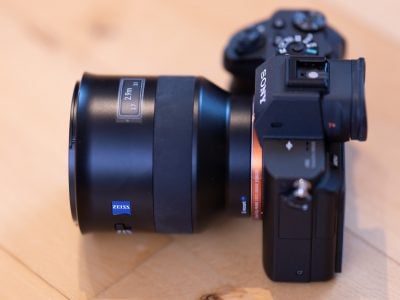Zeiss Batis 40mm f2 CF review
-
-
Written by Thomas
In depth
The Zeiss Batis 40mm f2 CF is a short standard prime lens designed to cover full-frame sensors and available in the Sony E-mount only. Announced in September 2018, it’s the latest member in the Batis series of five high quality primes lenses from Zeiss ranging from 18mm up to 135mm focal length. A special feature of this lens is its ability for close focus down to 0.24m (9.4in.) producing a magnification of 1:3.1. Thus the “CF” designation in the lens’ name.
On a full-frame camera the Zeiss Batis 40mm f2 CF delivers a field-of-view that’s 10 degrees wider than the standard 50mm lens (57 vs 47 degrees) and 7 degrees narrower than from a 35mm lens. It can still be considered a “normal” lens as its 40mm focal length is indeed closer to the 43mm diagonal of a full-frame sensor than a 50mm lens is. So images shot with this lens should produce a very natural and immersive perspective when viewed from a standard distance (equal to the diagonal of the print or monitor/screen). Use it on a Sony Alpha body with APS-C crop sensor and the Zeiss Batis 40mm f2 CF delivers a field of view that is equivalent to a 60mm lens. Combined with a bright f2.0 focal ratio it is well-suited for available-light use.
To find out whether the optical performance of the new Batis 40mm f2 CF makes it a worthy member of Zeiss’s Batis line I tested it on a 42MP Sony A7R II body against the Sony 35mm f1.4 ZA and the Sony 35mm f2.8 ZA, and also compared it to the Sigma 40mm f1.4 Art shot on the 46MP Nikon Z7.
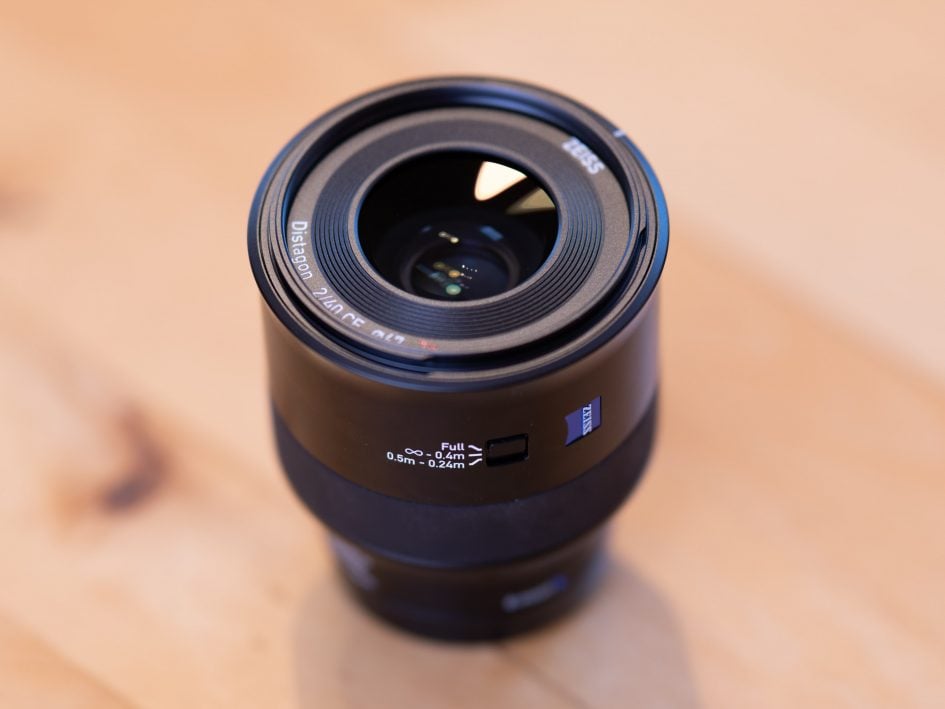
Facts from the catalog
As usual I’ll have a look at the technical data of the Zeiss Batis 40mm f2.0 CF first. I’ve rated the features with a [+] (or [++]), when it’s better than average or even state of the art, a [0] if it’s standard or just average, and [-] if there’s a disadvantage. For comparison I use the Sony 35mm f1.4 ZA, The Sony 35mm f2.8 ZA and the Sigma 40mm f1.4 Art (“Sigma Art” for short).
Size (diameter x length): 81 x 87mm (3.2 x 3.4in.) which is quite compact for an f2.0 lens. The lens hood adds 40mm (1.6in.) and is 91mm in diameter. The Sony 35mm f1.4 ZA at 79 x 112mm plus 37mm for the lens hood (98mm diameter) is quite long in comparison. But the Sigma Art tops them all at 88 x 157mm (3.5 x 6.2in.). The lens hood adds 50mm (2.0in.) and brings the total length of the Sigma Art to a whopping 21cm (8.2in.) showing its heritage as a DSLR design. The Sony 35mm f2.8 ZA is the smallest alternative in this comparison at 61mm diameter and only 48mm length including lens hood. [+]
Weight: 362g (13 oz.) plus 32g for the lens hood. The Sony 35mm f1.4 ZA is 630g (22 oz.) plus 30g lens hood, the Sigma Art is around 1270g (45 oz.) plus 61g for the lens hood. Keep in mind that both lenses offer a one stop larger focal ratio of f1.4. The smallest lens in this comparison, the Sony 35mm f2.8 ZA, is also the lightest at 132g incl. lens hood. [+]
Optics: The lens features 9 elements in 8 groups (including 5 special dispersion elements and two aspherical elements). The Sony 35mm f1.4 ZA has 12 elements in 8 groups, the Sigma Art 16 elements in 12 groups, and the Sony 35mm f2.8 ZA 7 elements in 5 groups. [+]
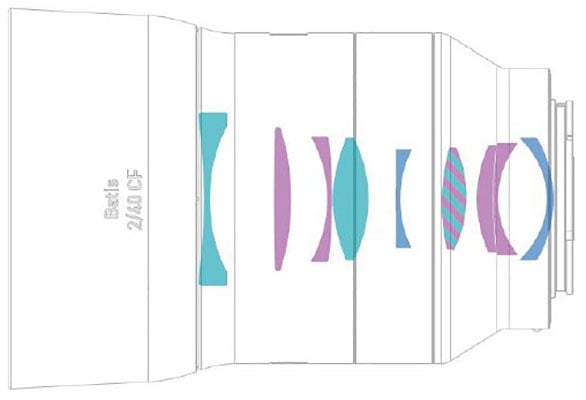
Closest focus distance is 0.24m (9.4in.) in manual focus resulting in a magnification of 1:3.1. Working distance is 14cm when the lens hood is removed. A magnification of 1:10 is achieved at 0.52m distance. The other lenses don’t reach a similar magnification: the Sony 35mm f1.4 ZA and the Sigma Art go down to around 1:5.5 while the Sony 35mm f2.8 ZA only achieves 1:7.5. [+]
Filter-thread: 67mm. The Sony 35mm f1.4 ZA takes 72mm filters, the Sigma Art 82mm. The Sony 35mm f2.8 ZA has a filter thread of 49mm on the lens or 40.5mm on the less hood. [+]
Image stabilization: No optical stabilization of the lens. The Sony A7 Mark II bodies onwards provide built-in sensor-shift stabilization. Same with the other lenses in this comparison. [0]
Auto focus: Built-in AF drive. Manual-focus override is by simply turning the focus ring. The focus ring has a non-linear gearing that allows for precise manual focus but makes smooth focus pulling for videographers almost impossible. The Zeiss Batis also offers a unique display for focus distance and depth of field. Unfortunately the display is hard to read under sunny conditions (in my photos of the lens you only see the factory sticker simulating the display). There’s also a focus limiter switch with three settings: full, infinity – 0.4m, 0.5m – 0.24m. Both Sony ZA lenses have no distance or dof markings. Focus on the Sigma Art works differently as it has a direct linear mechanical coupling between the focus ring and the focus action. It also offers the distance and dof markings that normally come with lenses designed for DSLRs. [+]
Covers full frame/FX or smaller. Same with the competition. [+]
Price: The lens currently sells for 1300 EUR (incl. 19% VAT) / 1300 USD. The Sony ZA is the most expensive lens in this comparison at 1500 EUR/USD while the Sigma Art is 1200 EUR / 1400 USD and the Sony 35mm f2.8 is the cheapest at 700 EUR / 750 USD. [0]
The Zeiss Batis lens comes in a nice package but has no pouch. The lens hood is included and is reversible for transport. The Sony 35mm f2.8 ZA also comes without pouch while the Sony 35mm f1.4 ZA has one. Only the Sigma Art comes equipped with what is fitting for lenses costing 4 figures: a nice padded pouch plus strap and a lens hood that is included and reversible for transport plus has a locking mechanism to prevent it from accidentally falling off. [-]
Aperture ring: no, just like the Sony 35mm f2.8 ZA and the Sigma Art. Only the Sony 35mm f1.4 ZA offers an aperture ring with 1/3 stop clicks which can be turned off for continuous, smooth, and noise-free operation. [0]
Sealing: yes, a rubber grommet at the lens-mount plus further special weather-sealing throughout the construction, just like the Sigma Art. Both Sony ZA lenses are similarly sealed inside but lack the rubber sealing at the lens-mount. [+]
The score in the “features-department” is 1[-]/3[0]/8[+] shows that the Zeiss Batis 40mm f2.0 CF is an attractive offering: It is small and light for a prime lens with a large f2.0 focal ratio, seems well built, and offers the unique features of an OLED display for distance and dof plus the ability to focus pretty close. Its biggest letdown is the missing pouch which is a disappointing omission when considering the price of this lens.
Four wide-angle prime lenses
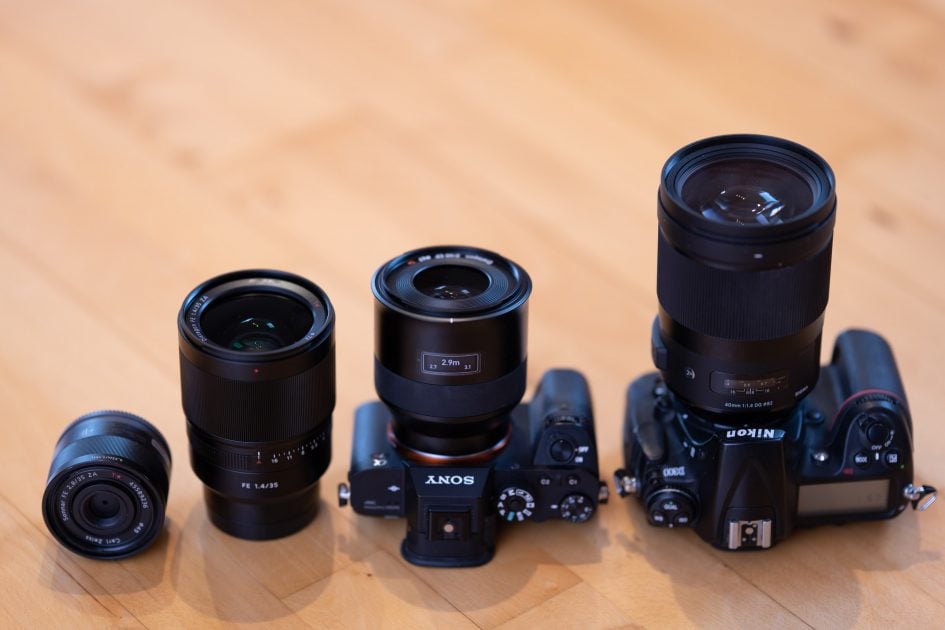
Above from left to right: Sony 35mm f2.8 ZA, Sony 35mm f1.4 ZA, Zeiss Batis 40mm f2.0, Sigma 40mm f1.4 Art
Alternatives
If you want a 40mm lens with a large focal ratio and autofocus there is only one alternative from Sigma:
- Sigma will have the 40mm f1.4 Art available for E-mount soon for 1200 EUR / 1400 USD. Its one stop faster focal ratio is the biggest advantage over the f2.0 Batis. But The Sigma Art is huge and heavy. See my Sigma 40mm f1.4 Art review where it earned a Highly Recommended.
Or you need to look at 35mm or manual focus lenses.
- Sigma also offers the 35mm f1.4 Art for a relatively low price of 750 EUR / 900 USD. It’s an optical design from 2012 for DSLRs which is also available in E-mount since 2018. See my Sigma 35mm f1.4 Art review where it came Highly Recommended when tested on a 36MP Nikon D800. At 755g the lens it’s much lighter than Sigma’s 40mm f1.4 Art.
- From Sony there’s the 35mm f1.4 ZA (1500 EUR/USD) plus the diminutive 35mm f2.8 ZA (700 EUR / 750 USD). Check back soon for my complete Sony 35mm f1.4 ZA review. And my 35mm f2.8 ZA review is also coming soon.
- Voigtländer offers the SL II Ultron 40mm f2.0 from 2012 which is a very small and light (63 x 25mm, 200g) pancake lens but manual focus only. Its native mounts are Nikon F or Canon EF but it can be used via an EF to E-Mount adapter on a Sony A7 body too. The lens sells for 530 EUR / 420 USD. Plus there’s the Nokton 40mm f1.2 for E-Mount for 1100 EUR/USD. Again, it’s manual focus only.
- Samyang/Rokinon/Walimex has a 35mm f1.4 AS UMC manual focus lens from 2011 that’s also available for Sony E-Mount (around 450 EUR / 400 USD). Plus there’s a newer version from 2017 for E-mount only that can autofocus (550 EUR / 530USD).
If you’re unsure of how big the differences between 50mm, 40mm, 35mm and even 28mm focal length are, here is the angle of view that the Zeiss Batis 40mm f2.0 CF covers on a full-frame body compared to the Sony 35mm f2.8 ZA:

Above: Sony 35mm f2.8 ZA (left), Zeiss Batis 40mm f2.0 CF (right)
Compare this to a 28mm and a 50mm lens:

Above: Zeiss Otus 28mm f1.4 left, Nikon Z 50mm f1.8S (right)
Focus
Focus accuracy and repeatability is critical to consistently produce sharp shots especially with large aperture lenses. Repeatability (the accuracy of focus on the same subject after repeated focus-acquisition) of this lens is very good (measured 98.6% in Reikan FoCal) with no outliers over a series of 40 shots. And there is no focus variation whether the lens focuses from a closer distance or from infinity.
The lens focuses in around 0.35 sec on a Sony A7R II from infinity to 0.52m (1:10 magnification), which is very fast. Both Sony ZA lenses are slower at 0.5 sec and the Sigma Art takes the longest to focus at 0.7 sec (on a Nikon Z7 with FTZ adapter). The focus ring is 19mm wide. It moves very smoothly and can easily be operated with one finger. My only gripe is that the focus ring is pretty close to the camera body: I often missed it on the first try. Both Sony ZA lenses also offer very smooth focus by wire operation.Only the Sigma Art has a much stiffer mechanical coupling between the focus ring and the focus action.
AF-operation of the Zeiss Batis is inaudible from the outside or if you record video with the built-in microphone – as are both Sonys. Only the Sigma Art produces an audible focus noise. As you pull focus, you’ll notice some focus breathing: the image of the Zeiss Batis becomes 6% more magnified when I adjusted the focus from infinity to 0.52m. This could be distracting when shooting videos but is par for the course: the other lenses in this comparison all increase their magnification between 5% and 6%.
Next check out my quality results!
Check prices on the Zeiss Batis 40mm f2 at Amazon, B&H, Adorama or WEX! Alternatively get yourself a copy of my In Camera book or treat me to a coffee! Thanks!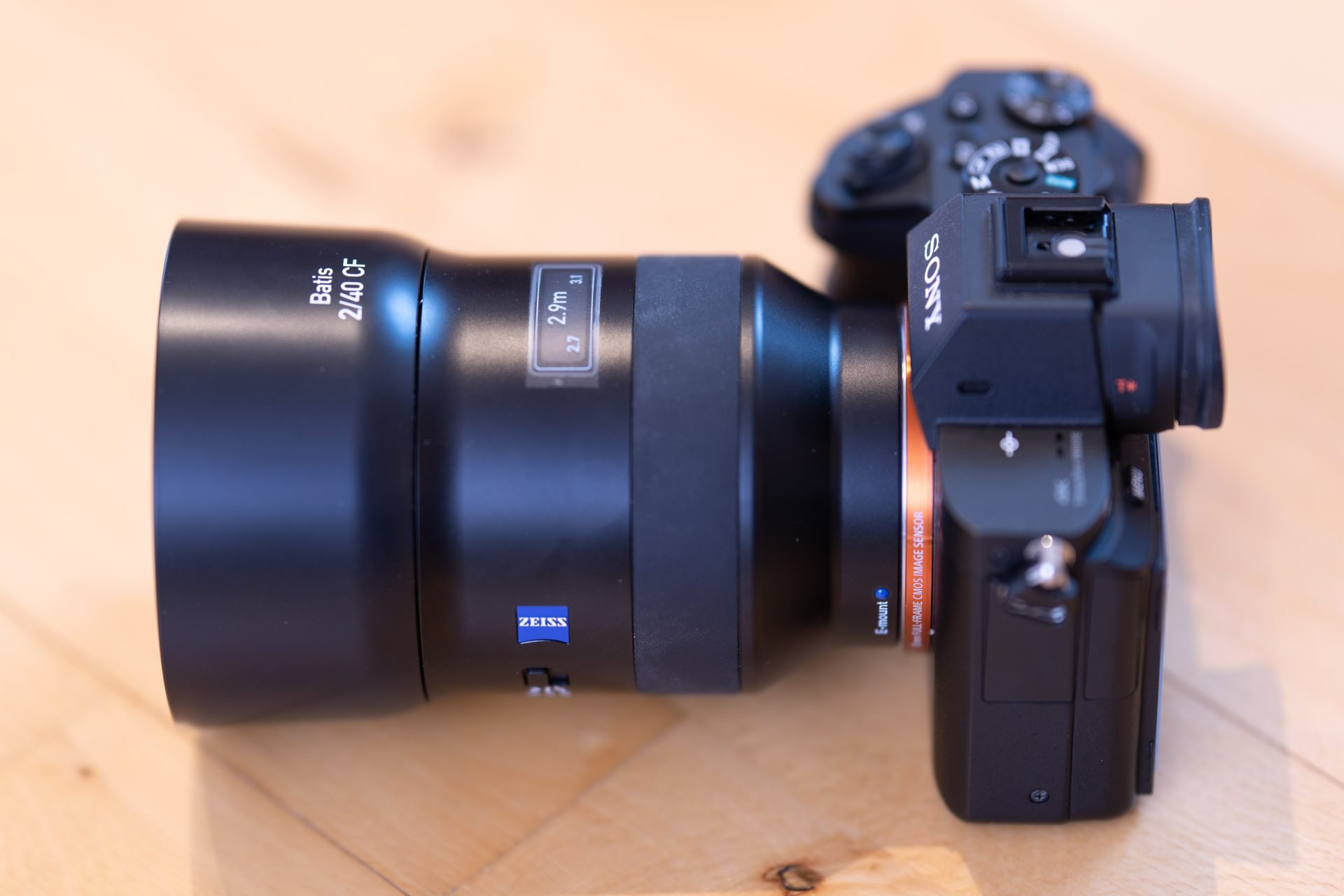
 The Zeiss Batis 40mm f2 CF is a short standard prime lens designed for Sony e-mount mirrorless cameras and corrected for full-frame models. The 40mm focal length falls between more common 35mm and 50mm models, but is actually closest to ‘normal’ coverage on a full-frame system, making it an ideal general-purpose prime with natural results; meanwhile the CF stands for close-focus, with the ability to focus-down to 24cm for a greater magnification than most rivals. Like other Batis lenses it also features an OLED display for useful distance and depth-of-field information. In my tests the Zeiss Batis 40mm f2 CF proved to be very sharp across the full-frame sensor in close quarters and at longer distances, had almost no color aberrations, and produced only little coma. This performance comes in a sleek-looking and well-sealed package that is comparably light and small. But the lens is not without flaws. The most obvious being the quality of its Bokeh compared to faster rivals and the light gathering power of its f2 focal ratio. Neither can compete with f1.4 lenses. Then there’s the relatively high price which doesn’t even include a lens pouch. If you’re satisfied by the f2 aperture and its resulting bokeh and light-gathering though, the Zeiss Batis 40mm f2 CF is an attractive lens: sharp into the corners with low color aberrations and minimal coma, coupled with a useful close focusing ability. Combined with moderate size and weight plus thorough weather-sealing and solid build quality, the Zeiss Batis 40mm f2 CF earns a Highly Recommended!
The Zeiss Batis 40mm f2 CF is a short standard prime lens designed for Sony e-mount mirrorless cameras and corrected for full-frame models. The 40mm focal length falls between more common 35mm and 50mm models, but is actually closest to ‘normal’ coverage on a full-frame system, making it an ideal general-purpose prime with natural results; meanwhile the CF stands for close-focus, with the ability to focus-down to 24cm for a greater magnification than most rivals. Like other Batis lenses it also features an OLED display for useful distance and depth-of-field information. In my tests the Zeiss Batis 40mm f2 CF proved to be very sharp across the full-frame sensor in close quarters and at longer distances, had almost no color aberrations, and produced only little coma. This performance comes in a sleek-looking and well-sealed package that is comparably light and small. But the lens is not without flaws. The most obvious being the quality of its Bokeh compared to faster rivals and the light gathering power of its f2 focal ratio. Neither can compete with f1.4 lenses. Then there’s the relatively high price which doesn’t even include a lens pouch. If you’re satisfied by the f2 aperture and its resulting bokeh and light-gathering though, the Zeiss Batis 40mm f2 CF is an attractive lens: sharp into the corners with low color aberrations and minimal coma, coupled with a useful close focusing ability. Combined with moderate size and weight plus thorough weather-sealing and solid build quality, the Zeiss Batis 40mm f2 CF earns a Highly Recommended!



